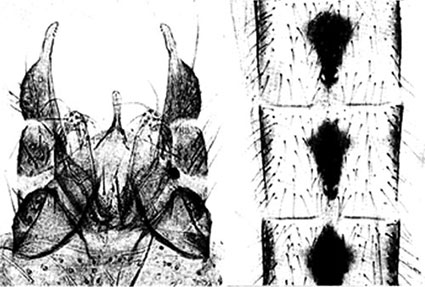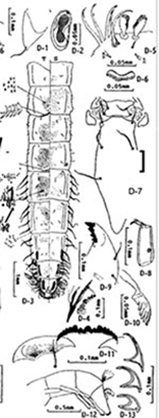Chironomus okinawanus Hasegawa & Sasa, 1987. Synonyms: Chironomus okicontractus Sasa, 1993: 125; Yamamoto & Yamamoto 2014: 313.[Holotype: male, No. 246:01; holotype missing?]. Chironomus tokarabeceus Sasa & Suzuki 1995 (Yamamoto & Yamamoto 2018) Adults Wing length 2.81 (2.50-3.01), setae on squamal fringe 15 (13-20); AR 3.28 (3.07-3.51). Setae: Clypeal 20.3 (16-23); Acrostichal 19.1 (16-23); Dorsocentral 17.8 (15-24); Prealar 7.9 (6-11); Scutellar 19.3 (16-23). LRI 1.53 (1.49-1.56); LR2 0.64 (0.62-0.66; LR3 0.75 (0.73-0.78); BR 12.5 (2.3-2.6). Antennal hairs brown, shaft dark brown; ground color of scutum yellow, scutal stripes reddish brown, scutellum yellow, postnotum dark brown, halteres yellow; wings unmarked, r-m dark brown; in all legs, femur and tibia are entirely yellow, tarsi I, II and III largely yellow and each with an apical dark ring, tarsi IV and V largely dark brown; ground color of abdominal targites greenish yellow, tergites I to VII each with a large central dark patch which is almost triangular in tergites II to IV (Fig. below); tergites VIII and hypopygium dark brown. Frontal tubercles well developed, about twice as long as wide. Lateral pronotal setae absent. Hypopygium (see Fig. 1, below). Ninth tergite with 12-16 long setae in the middle. Anal point slender and slightly expanded apically. Superior Volsella (Fig. I below) composed of a relatively high, triangular base bearing several long setae, and a hook-like apical process. Inferior Volsella (Fig. 1, below) relatively short, stout and almost parallel-sided, with 14 long and recurved setae arising from apical 1/5. Gonostylus abruptly narrowed at about apical 1 /3.  From Sasa & Hasegawa 1983. Female (From Sasa & Hasegawa 1983):  Pupa: (from Hasegawa & Sasa (1987) (Fig. 2, D1-4, below) Exuviae brown in color, thorax, lateral margins of abdomen and anal lobes darker than the rest part. Length of abdomen 4.2-6.6 (mean 5.7) mm. Cephalic tubercles conical, each with a preapical seta which is about half the length of the cephalic tubercle. Thoracic respiratory organ and chaetotaxy as in usual Chironomus. Tergite I without spines and spinules; II to VI each with a central spinose area, and that on VI sometimes divided into anterior and posterior groups; VII with a pair of anterolateral spinulous areas; VIII with a pair of midlateral spinulous areas; a row of relatively small recurved spines present on caudal margin of tergite II, lateral spines of this row simple but median ones with accessory spikes. Spinules also present on caudolateral corners of tergites V to VII. Intersegmental spinulous areas present on caudal margins of tergites IV to VI. Sternite I with a pair of anterolateral spinulous areas and a caudomedial spinulous area; II with spinules wide1y in the central area and along lateral margins; III with a large central spinulous area, which is sometimes divided into the anterior and the posterior groups, and with spinules in anterior part of lateral margins; IV with a T-form spinulous area and a pair of caudolateral whirl-like spinose areas; V with a pair of anterolateral spinulous areas and caudal spinulous area; VI and VII each with anterolateral spinulous areas which often confluent medially forming a transverse band; VIII without spinules. Caudolateral scales of abdominal segment VIII elongated and apically divided into 1 to 4 pointed spurs. Anal lobe with 75 to 113 (mean 92.8) fringe hairs. Fourth instar larva: (Fig. 2: D-5 to 13, at right). (Apparently a melanotus-type larva). Cytology: Not known. Hasegawa & Sasa (1987) note that the adult is closest to C. praeapicalis Tokunaga (1964); while the pupa is similar to C. circumdatus in having a pair of spinulous areas in place of transverse band of spinules on the anterior part of tergite VII, but differs in possesing spinulous areas on the antero-lateral corners of sternite I. Yamamoto (2002) has suggested that this species is related to C. javanus. Found: Japan - Type locality - Okinawa, Okinawa Prefecture, Ryukyus.(In Toyama Medical and Pharmaceutical University, Toyama, Japan). |
Created: 26 February 2022
Access: Unrestricted
Copyright © 2022, Jon Martin.